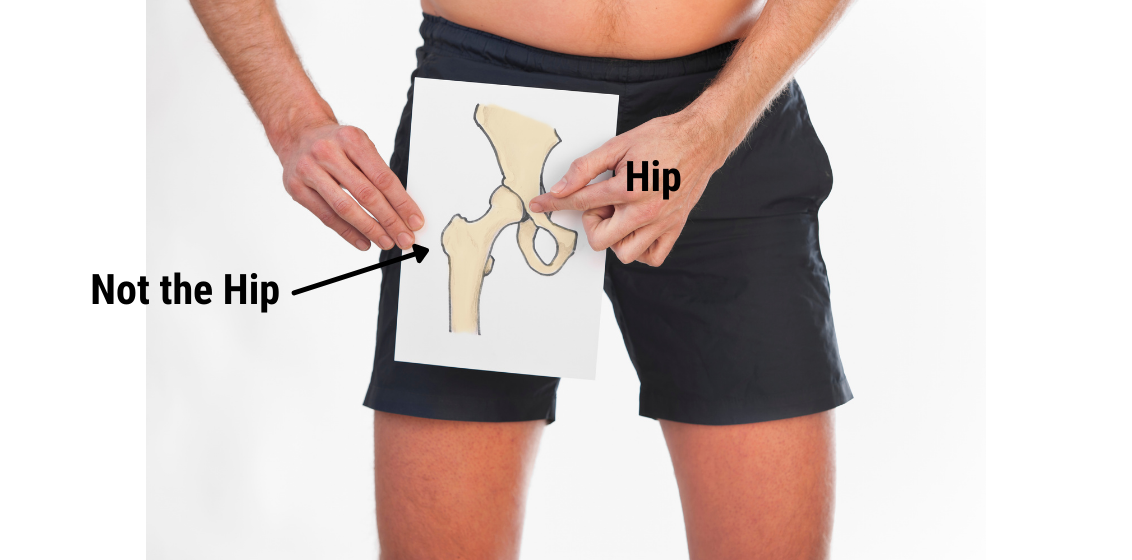Groin Pain: Is it Your Hip?

Did you know that pain in your groin is most likely to be coming from your hip? This can be confusing, as most people think of the hip as the bit on the outer side of the thigh, but if we look at the anatomy, we can see that the ball and socket of the hip joint is a long way inland from there and right under what most of us call the “groin”.
As Physiotherapists, how do we make sense of groin pain and decide it’s coming from your hip?
This is more difficult than it seems. Your lower back, sacro-iliac joint and pelvic girdle as well as numerous muscles can also produce or refer pain into the groin area.
First, we must ask the right questions and listen closely to your story; your age, the location of pain, how the symptoms came on and when it bothers you the most. Clicking, catching, and giving way and how it behaves through the day. Research shows us that this information gets us 60-90% of the way to being able to confidently diagnose or rule out a hip joint problem.
Important parts of your story include a limp, groin pain and decreased hip rotation which increase the likelihood of a hip problem being the culprit by up to 14 times compared to referred pain from elsewhere!
Once we are suspicious you could have a hip problem, we then go through a process of ruling out the other possible causes with examination tests proven to be the most accurate in helping our decision making. We use tests that are highly sensitive and help us rule out each potential source of pain until by exclusion we are confident we know the source of your problem. We go through this process every time we see someone with groin pain. If we get you to touch your toes or bend and twist your back, we’re ruling out lower back causes for your pain.
Now that we are highly confident that the other areas are unlikely to be the culprit and that your hip joint is most likely to be the problem, we try and accurately diagnose exactly what’s wrong with your hip.
Some parts of your story help us here
- Your age: growth plate problems happen in kids and osteo-arthritis in older folks, labral tears and hip impingement happen in the years in between
- Clicking, catching and giving way with sharp pain all but diagnose a labral tear while inability to squat deeply points towards hip impingement or arthritis
- Female endurance athletes with groin pain while running are assumed to have a stress fracture in their femur until we can prove otherwise
We can then perform some special examination tests to try and pinpoint the exact diagnosis. Unfortunately, these tests aren’t as accurate as a PCR nose swab test for a virus, so we usually combine a cluster of hip tests with your story to form the most likely hypothesis. More often we use individual tests to rule out things like labral tears or hip impingement and arrive at the diagnosis by exclusion.
What about scans?
We generally only use Xray’s or scans to confirm our suspicions of a serious condition that needs specialist treatment. Unfortunately, MRI is too good at finding things in most people, and a lot of pain free hips will show signs of labral tears, osteoarthritis and impingement. MRI can often confuse the issue by showing up a lot of normal “wear and tear” that is not producing pain. For instance, there is no difference in the number of labral tears that show up in the painful and pain-free hip of people having MRI for that condition.
We hope that gives you an insight into the process going on between our ears when we see you for the first time with groin or hip pain. We are always reading new research into examination techniques to help our clinical reasoning and decision making. We share these in our weekly Clinical Education sessions as a team and in our updated clinical pathways for common injuries.
If we seem like we are asking you a lot of questions, it’s because your story is the biggest pointer towards the right diagnosis and with the right diagnosis we can prescribe the right plan of action.



